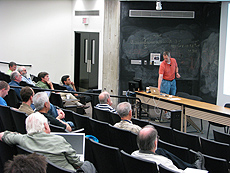Project X Physics Study shows a way forward for Fermilab
 |
Fermilab and University of Illinois physicist Kevin Pitts discusses kaon experiments at the Project X Physics Study on Thursday. Photo: Joseph Piergrossi |
Fermilab physicist and Project X participant Bob Bernstein summed up this week's Project X Physics Study in one word: "Intense."
In more ways than one, the word is apt for the workshop whose goal is to define the flagship effort of the Intensity Frontier at Fermilab. About 215 participants from around the United States and the world have used the past week to plan their experiments for the new accelerator project.
Plans involved plenary and breakout sessions in which particle physicists with various interests could collaborate and discuss new directions for the lab.
"It's one of the better conferences I've been to," Bernstein said. "There were kaon people talking to neutrino people talking to electric-dipole-moment people – not something you see too often."
Fellow Fermilab physicist Andreas Kronfeld said the participants all expressed high hopes for Project X, which is expected to begin construction in the latter part of the decade. This week's workshop, run by Project Scientist Bob Tschirhart and Project Manager Steve Holmes, was meant to get scientists thinking about the experiments they would run.
"I see this as particularly good because it is like a new field where you can bring new ideas and proposals," said scientist Yuri Kamyshkov of the University of Tennessee. "We need to inject new ideas, and that is what our group is trying to do."
One such idea Kamyshkov said he was considering would test the possibility of matter becoming antimatter.
"This is an idea that has not been explored enough before but that has a very good theoretical motivation," he said.
Kamyshkov added that the collaborative nature of the conference allowed each experiment to debate the sorts of instrumentation necessary for all of these experiments.
Scientists will present plans started at this conference in greater detail at next year's Snowmass conference, a meeting of members of the high-energy physics community hosted by the American Physical Society Division of Particles and Fields.
Tschirhart will give a summary talk on the Project X Physics Study this afternoon at 4 p.m. in One West.
—Joseph Piergrossi
|